Swaminarayan
Swaminarayan (IAST: Svāmīnārāyaṇa, 3 April 1781 – 1 June 1830), also known as Sahajanand Swami, was a yogi and ascetic whose life and teachings brought a revival of central Hindu practices of dharma,[2] ahimsa[3][4] and brahmacarya.[2] He is believed by followers to be a manifestation of God.[5][6]
Swaminarayan | |
|---|---|
 Illustration of Swaminarayan writing the Shikshapatri | |
| Personal | |
| Born | Ghanshyam Pande 3 April 1781[1] |
| Died | 1 June 1830 (aged 49) |
| Religion | Hinduism |
| Founder of | Swaminarayan Sampraday |
| Religious career | |
| Guru | Swami Ramanand |
| Mount | Manki Ghodi |
| Other names | Sahajanand Swami, HariKrishna Maharaj, Nilkanth Varni, Swaminarayan Bhagawan |
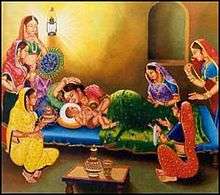
Swaminarayan was born Ghanshyam Pande in Chhapaiya, Uttar Pradesh, India in 1781. In 1792, he began a seven-year pilgrimage across India at the age of 11 years, adopting the name Nilkanth Varni. During this journey, he did welfare activities and after 9 years and 11 months of this journey, he settled in the modern day Indian state of Gujarat around 1799. In 1800, he was initiated into the Uddhav sampradaya by his guru, Swami Ramanand, and was given the name Sahajanand Swami. In 1802, his guru handed over the leadership of the Uddhav Sampraday to him before his death. Sahajanand Swami held a gathering and taught the Swaminarayan Mantra. From this point onwards, he was known as Swaminarayan. The Uddhav Sampraday became known as the Swaminarayan Sampradaya.
Swaminarayan developed a good relationship with the British Raj.[7][8] He had followers not only from Hindu denominations but also from Islam and Zoroastrianism. He built six temples in his lifetime[9] and appointed 500 paramahamsas to spread his philosophy.[10] In 1826, Swaminarayan wrote the Shikshapatri, a book of social principles.[11] He died on 1 June 1830 and was cremated according to Hindu rites in Gadhada, Gujarat. Before his death, Swaminarayan appointed his adopted nephews as acharyas to head the two dioceses of Swaminarayan Sampradaya. Swaminarayan is also remembered within the sect for undertaking reforms for women[12] and the poor,[13] and performing non-violent yajñas (fire sacrifices) on a large scale.[7]
Childhood as Ghanshyam
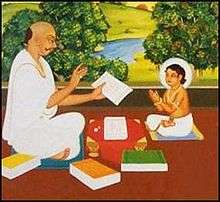
Swaminarayan was born on 3 April 1781 (Chaitra Sud 9, Samvat 1837) in Chhapaiya, Uttar Pradesh, a village near Ayodhya, in a Hindi speaking region in India.[1] Born into the brahmin or priestly caste of Sarvariya, Swaminarayan was named Ghanshyam Pande by his parents, Hariprasad Pande (father, also known as Dharmadev) and Premvati Pande (mother, also known as Bhaktimata and Murtidevi).[1] The birth of Swaminarayan coincided with the Hindu festival of Rama Navami, celebrating the birth of Rama. The ninth lunar day in the fortnight of the waxing moon in the month of Chaitra (March–April), is celebrated as both Rama Navami and Swaminarayan Jayanti by Swaminarayan followers. This celebration also marks the beginning of a ritual calendar for the followers.[14] Swaminarayan had an elder brother, Rampratap Pande, and a younger brother, Ichcharam Pande.[15] He is said to have mastered the scriptures, including the Vedas, the Upanishads, the Puranas, the Ramayana, and the Mahabharata by the age of seven.[16]
Travels as Nilkanth Varni
After the death of his parents, Ghanshyam Pande left his home on 29 June 1792 (Ashadh Sud 10, Samvat 1849) at the age of 11.[17] He took the name Nilkanth Varni while on his journey. Nilkanth Varni travelled across India and parts of Nepal in search of an ashram, or hermitage, that practiced what he considered a correct understanding of Vedanta, Samkhya, Yoga, and Pancaratra, the four primary schools of Hindu philosophy.[18] To find such an ashram, Nilkanth Varni asked the following five questions on the basic Vaishnava Vedanta categories:[19]
- What is Jiva?
- What is Ishvara?
- What is Maya?
- What is Brahman?
- What is Parabrahman?
While on his journey, Nilkanth Varni mastered Astanga yoga (eightfold yoga) in a span of 9 months under the guidance of an aged yogic master named Gopal Yogi.[20] In Nepal, it is said that he met King Rana Bahadur Shah and cured him of his stomach illness. As a result, the king freed all the ascetics he had imprisoned.[21] Nilkanth Varni visited the Jagannath Temple in Puri as well as temples in Badrinath, Rameswaram, Nashik, Dwarka and Pandharpur.[17]
In 1799, after a seven-year journey, Nilkanth's travels as a yogi eventually concluded in Loj, a village in the Junagadh district of Gujarat. In Loj, Nilkanth Varni met Muktanand Swami, a senior disciple of Ramanand Swami. Muktanand Swami, who was twenty-two years older than Nilkanth, answered the five questions to Nilkanth's satisfaction.[22] Nilkanth decided to stay for the opportunity to meet Ramanand Swami, whom he met a few months after his arrival in Gujarat.[23] He later claimed in the Vachnamrut that during this period, he took up a severe penance to eliminate his mothers flesh and blood from his body so that the sign of his physical attachment to family, was completely removed.[18]
Leadership as Sahajanand Swami
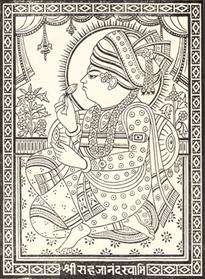
According to the sect, Nilkanth's understanding of the metaphysical and epistemological concepts of the pancha-tattvas (five eternal elements), together with his mental and physical discipline, inspired senior swamis of Ramanand Swami.[24]
Nilkanth Varni received sannyasa initiation from Ramanand Swami on 20 October 1800, and with it was granted the names Sahajanand Swami and Narayan Muni to signify his new status.[25]
At the age of 21, Sahajanand Swami was appointed successor to Ramanand Swami as the leader of the Uddhav Sampradaya[25] by Ramanand Swami, prior to his death. The Uddhav Sampradaya henceforth came to be known as the Swaminarayan Sampradaya.[26] According to sources he proclaimed the worship of one sole deity, Krishna or Narayana.[27] Krishna was considered by him his own ista devata. In contrast with the Vaishnava sect known as the Radha-vallabha Sampradaya,[28] he had a more puritanical approach, rather than the theological views of Krishna that are strongly capricious in character and imagery. While being a worshipper of Krishna, Swaminarayan rejected licentious elements in Krishnology in favor of worship in the mood of majesty, alike to earlier Vaisnava teachers, Ramanuja and Yamunacharya.[29]
Sahajanand Swami was later known as Swaminarayan after the mantra he taught at a gathering, in Faneni, a fortnight after the death of Ramanand Swami.[30] He gave his followers a new mantra, known as the Swaminarayan mantra, to repeat in their rituals: Swaminarayan.[25] When chanting this mantra, some devotees went into samadhi (a form of meditation)[31][n 1] This act is also called maha-samadhi ("great samadhi") and claimed that they could see their personal gods, even though they had no knowledge of Astanga Yoga.[20][32][33] Swaminarayan also became known by the names Ghanshyam Maharaj, Shreeji Maharaj, Hari Krishna Maharaj and Shri Hari. As early as 1804, Swaminarayan, who was reported to have performed miracles, was described as a manifestation of God in the first work written by a disciple and paramhansa, Nishkulanand Swami.[25][34] This work, the Yama Danda, was the first piece of literature written within the Swaminarayan sect.[35]
Swaminarayan encouraged his followers to combine devotion and dharma to lead a pious life. Using Hindu texts and rituals to form the base of his organisation, Swaminarayan founded what in later centuries would become a global organisation with strong Gujarati roots.[36] He was particularly strict on the separation of sexes in temples.[37] Swaminarayan was against the consumption of meat, alcohol or drugs, adultery, suicide, animal sacrifices, criminal activities and the appeasement of ghosts and tantric rituals.[38][39][40][41] Alcohol consumption was forbidden by him even for medicinal purposes.[42] Many of his followers took vows before becoming his disciple. He stated that four elements need to be conquered for ultimate salvation: dharma, bhakti (devotion), gnana (knowledge) and vairagya (detachment).[43] Doctrinally, Swaminarayan was close to eleventh century philosopher Ramanuja and was critical of Shankaracharya's concept of advaita, or monistic non-dualism. Swaminarayan's ontology maintained that the supreme being is not formless and that God always has a divine form.[44]
Work and views
Women
Swaminarayan insisted that education was the inherent right of all people, including women, despite considerable criticism from those in his own contemporary society who "loathed the uplift of lower caste women".[45] At that time, influential and wealthy individuals educated their girls through private and personal tuition. Male followers of Swaminarayan made arrangements to educate their female family members. The literacy rate among females began to increase during Swaminarayan's time, and they were able to give discourses on spiritual subjects.[46] Members of the sect consider Swaminarayan a pioneer of education of females in India.[47][48][49][50][51]
According to the author Raymond Brady Williams, "Swaminarayan is an early representative of the practice of advocacy of women's rights without personal involvement with women".[52] To counter the practice of sati (self-immolation by a widow on her husband’s funeral pyre), Swaminarayan argued that, as human life was given by God it could be taken only by God, and that sati had no Vedic sanction. He went to the extent to call sati nothing but suicide. Swaminarayan offered parents help with dowry expenses to discourage female infanticide, calling infanticide a sin.[47][48] For calling a halt to these prevailing practices, Swaminarayan's "contemporaries naturally saw in him a pioneer of a reformed and purified Hinduism, and Swaminarayan Hinduism an ‘ingrazi dharma’ or British religion."[46]
Professor David Harman observed that Swaminarayan "criticized the popular shakta cults and 'gosai' and 'nath' ascetics for the contemptuous and instrumental way in which they viewed and treated women. These cults were often responsible for gross sexual abuse of women."[53] Hardiman added that Swaminarayan's view towards women was not in line with this type of misogyny and was rooted in his desire to prevent ill treatment of women along with promoting celibacy for ascetics.[53] Swaminarayan "forbade all sadhus and sadhvis (that is, male and female ascetics) of his sect from having any contact whatsoever with members of the opposite sex."[53] This strict precept was one he likely internalized "after travelling as an ascetic throughout India [when] he was reported to vomit if approached by even the shadow of a woman".[54] To help his male ascetic followers maintain their vow of celibacy, Swaminarayan taught “the woman who attracts attention is made up of bones, blood vessels, spittle, blood, mucus and feces; she is simply a collection of these things, and there is nothing to be attractive.[53][55]
Members of the faith are defensive of the fact that some practices seem to restrict women and make gender equality in leadership impossible.[56] They are only permitted to enter special sections of the temple reserved for women or have to go to separate women's temples.[53] As with practices of niddah in Orthodox Judaism, concepts of pollution associated with the menstrual cycle lead to the exclusion of women from the temples and daily worship during the affected time.[57] Swaminarayan also directed male devotees not to listen to religious discourses given by women.[49]
In case of widows, Swaminarayan directed those who could not follow the path of chastity to remarry. For those who could, he lay down strict rules which included them being under the control of male members of the family. This may seem regressive, however it gave them "a respected and secure place in the social order" of the time.[58] Swaminarayan restricted widows "to live always under the control of male members of their family and prohibited them from receiving instruction in any science from any man excepting their nearest relations."[49]
Caste system and the poor
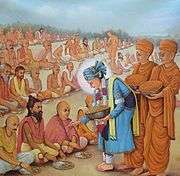
After assuming the leadership of the sampradaya, Swaminarayan worked to assist the poor by distributing food and drinking water.[59] He undertook several social service projects and opened almshouses for the poor. Swaminarayan organized food and water relief to people during times of drought.[60] The faith largely had excluded the mass of the poor, such as marginal peasants, agricultural labourers, the informal sector working class, adivasis and dalits. Dalits were banned from Swaminarayan temples from the beginning though in one case a separate temple was created for their use.[53]
Some suggest that Swaminarayan worked towards ending the caste system, allowing everyone into the Swaminarayan Sampradaya. However partaking in the consumption food of lower castes and caste pollution was not supported by him.[42] A political officer in Gujarat, Mr. Williamson reported to Bishop Herber that Swaminarayan had "destroyed the yoke of caste."[52] He instructed his paramhansas to collect alms from all sections of society and appointed people from the lower strata of society as his personal attendants. Members of the lower castes were attracted to the movement as it improved their social status.[38][49] Swaminarayan would eat along with the lower Rajput and Khati castes but not any lower.[61] He established separate places of worship for the lower caste population where they were in large numbers.[62] However, Dalits - those outside of the caste system - were formally excluded from Swaminarayan temples.[63] Members of a lower caste are prohibited from wearing a full sect mark (tilak chandlo) on their forehead.[64] Even now, however, for the vast majority of Gujarat's lower-caste, Untouchable and tribal population, the sect is out of bounds.[65]
Reginald Heber, the Lord Bishop of Calcutta, noted that disciples of Swaminarayan cut across all castes, and even included Muslims. He writes "they all pray to one God with no difference of castes. They live as if they were brothers."[66] Furthermore, in a meeting with Swaminarayan, he noted that "[Swaminarayan] did not regard the subject as of much importance, but that he wished not to give offense (to ancient Hindu system); that people might eat separately or together in this world, but that above "oopur" pointing to heaven, those distinctions would cease."[66] Swaminarayan worked thus to dispel the myth that moksha (salvation) was not attainable by everyone.[67] He taught that the soul is neither male nor female, nor yoked to any specific caste.[38][68]
Animal sacrifices and yajnas
Swaminarayan was against animal sacrifices as carried out by Brahmin priests during Vedic rituals, such as yajnas (fire sacrifices), influenced by the Kaula and Vama Marg cults.[69] The priests consumed "sanctified" prasad in the form of meat of these animals. To solve this problem, Swaminarayan conducted several large-scale yajnas involving priests from Varanasi. These did not have animal sacrifices and were conducted in strict accordance with Vedic scriptures. Swaminarayan was successful in reinstating ahimsa through several such large-scale yajnas. Swaminarayan stressed lacto vegetarianism among his followers and forbade meat consumption, codifying the conduct in the Shikshapatri.[42][49][70][71]
Establishing Law and Order of Gujarat
During the time when Swaminarayan came to Gujarat, the law and order situation of Gujarat was in worst ever. Neither British government nor local kings were able to control the robberies, killings, internal conflicts, rapes, and other uncultured events in Kathiyawar, Kutch and Gujarat. Upon reaching to Gujarat, Swaminarayan by His preaching and super natural divine power restored noted notorious criminals as normal civilians. These criminals left their evil nature and started living life with high moral values to the extent that they would never rob, or kill any living being. Even they would not see the unknown women or would not drink alcohol and be strict vegetarian.[72][73] Bombay Governor Sir Malcolm was impressed by social reforms of Swaminarayan and so had come down to Rajkot to meet Swaminarayan personally and to appreciate His work towards educating high moral values to the people of Gujarat and helping British Government in reducing criminal graph of Gujarat. Swaminarayan had vowed not to kill the evil people but to kill their evil nature.
The Bishop of Calcutta also noted that Swaminarayan "preached a great degree of purity, forbidding his disciples so much as to (not) look on any woman whom they passed. He condemned theft and bloodshed; and those villages and districts which had received him, from being among worst, were now among the best and most orderly in the provinces."[66]
Temples and ascetics

Swaminarayan ordered the construction of several Hindu temples and he had built six huge temples by himself and installed the idols of various deities such as Nara-Narayana in two temples, Laxminarayan Dev, Gopinathji Maharaj, Radha Raman Dev and Madanmohan Lalji . The images in the temples built by Swaminarayan provide evidence of the priority of Krishna.[74]:81[75] Disciples of Swaminarayan composed devotional poems which are widely sung by the tradition during festivals.[76][77] Swaminarayan introduced fasting and devotion among followers.[78] He conducted the festivals of Vasant Panchami, Holi, and Janmashtami with organization of the traditional folk dance raas.[20]
The first temple Swaminarayan constructed was in Ahmedabad in 1822, with the land for construction given by the British Imperial Government.[79][80] Following a request of devotees from Bhuj, Swaminarayan asked his follower Vaishnavananand to build a temple there. Construction commenced in 1822, and the temple was built within a year.[79] A temple in Vadtal followed in 1824,[79] a temple in Dholera in 1826,[79] a temple in Junagadh in 1828[79] and a temple in Gadhada, also in 1828.[79] By the time of his death, Swaminarayan had also ordered construction of temples in Muli, Dholka and Jetalpur.[81]
From early on, ascetics have played a major role in the Swaminarayan sect. They contribute towards growth and development of the movement, encouraging people to follow a pious and religious life.[82] Tradition maintains that Swaminarayan initiated 500 ascetics as paramhansas in a single night. Paramhansa is a title of honour sometimes applied to Hindu spiritual teachers who are regarded as having attained enlightenment. Paramhansas were the highest order of sannyasi in the sect.[83] Prominent paramhansas included Muktanand Swami, Gopalanand Swami, Brahmanand Swami, Gunatitanand Swami, Premanand Swami, Nishkulanand Swami, and Nityanand Swami.[84]
Scriptures
Swaminarayan propagated general Hindu texts.[36] He held the Bhagavata Purana in high authority.[85] However, there are many texts that were written by Swaminarayan or his followers that are regarded as shastras or scriptures within the Swaminarayan sect. Notable scriptures throughout the sect include the Shikshapatri and the Vachanamrut. Other important works and scriptures include the Satsangi Jeevan, Swaminarayan's authorized biography, the Muktanand Kavya, the Nishkulanand Kavya and the Bhakta Chintamani.[86]
Shikshapatri
Swaminarayan wrote the Shikshapatri on 11 February 1826.[87] While the original Sanskrit manuscript is not available, it was translated into Gujarati by Nityanand Swami under the direction of Swaminarayan and is revered in the sect.[42][88] The Gazetteer of the Bombay Presidency summarised it as a book of social laws that his followers should follow.[89] A commentary on the practice and understanding of dharma, it is a small booklet containing 212 Sanskrit verses, outlining the basic tenets that Swaminarayan believed his followers should uphold in order to live a well-disciplined and moral life.[86] The oldest copy of this text is preserved at the Bodleian Library of Oxford University and it is one of the very few presented by Sahajanand Swami himself. Acharya Tejendraprasad of Ahmedabad has indicated in a letter that he is not aware of any copy from the hand of Sahajanand older than this text.[88]
Swaminarayan in various places of Shikshapatri describes Shri Krishna as the greatest entity. In Shikshapatri shlok 1 and 108 are few places that mentions that Swaminarayan prayed on Shri Krishna.
Shikshapatri shlok 1
वामे यस्य स्थिता राधा श्रीश्च यस्यास्ति वक्षसि ।
वृन्दावनविहारं तं श्रीकृष्णं हृदि चिन्तये ॥ 1॥
vāmē yasya sthitā rādhā śrīśca yasyāsti vakṣasi ǀ
vṛndāvanavihāraṁ taṁ śrīkṛṣṇaṁ hṛdi cintayē ǁ 1 ǁ
Translation: With all My heart, I meditate on Shri Krishna, who resides in the divine abode Vrindavan; with Radha on his left and Shree residing within his heart.[90][91]
Shikshapatri shlok 108 also mentions that Shri Krishna is the greatest entity.
स श्रीकृष्णः परंब्रह्म भगवान् पुरुषोत्तमः ।
उपास्य इष्टदेवो नः सर्वाविर्भावकारणम् ॥ 108॥
sa śrīkṛṣṇaḥ parambrahma bhagavān puruṣōttamaḥ ǀ
upāsya iṣṭadēvō naḥ sarvāvirbhāvakāraṇam ǁ 108 ǁ[90][92]
Translation: The Lord, Shri Krishna is the greatest entity. I admire Him the most. He is the cause of all incarnations and is thus truly worthy to be worshiped.
Vachanamrut
The Vachanamrut (IAST: Vacanāmṛta, lit. "immortalising ambrosia in the form of words") is a sacred Hindu text consisting of 273 religious discourses delivered by Swaminarayan from 1819 to 1829 CE and is considered the principal theological text within the Swaminarayan Sampradaya.[93]:6 Compiled by four of his senior disciples, Swaminarayan edited and approved the scripture. As followers believe Swaminarayan to be Parabrahman, or God, the Vachanamrut is considered a direct revelation from God and thus the most precise interpretation of the Upanishads, Bhagavad Gita, and other important Hindu scriptures.[93]:13–14, 45[94]:173 In the Vachanamrut, Swaminarayan outlines the Akshar-Purushottam Darshan and the necessity of the Aksharbrahman guru to attain moksha, a spiritual state characterised by eternal bliss and devotion to God.[95]:31[93]:47 This scripture is read by followers regularly and discourses are conducted daily in Swaminarayan temples around the world.[96]:21–27
Satsangi Jeevan
Satsangi Jeevan is the authorised biography of Swaminarayan.[93] The book contains information on the life and teachings of Swaminarayan.[97] It is written by Shatanand Swami and completed in Vikram Samvat 1885.[93] Swaminarayan decided to make Gadhada his permanent residence on the insistence of Dada Khachar and his sisters.[98] Swaminarayan instructed Shatanand Swami to write a book on his life and pastimes.[94]
To enable Shatanand Swami to write from His childhood, Swaminarayan had blessed Shatanand Swami with Sanjay Drishti - special power to see the entire past right from His childhood.[94]
Once written by Shatanand Swami, this book was verified and authenticated by Swaminarayan. He was much pleased to read the book. Swaminarayan then asked his disciples to do Katha of Satsangi Jeevan.[94]
Mahatma Gandhi on Swaminarayan
In relation to Swaminarayan's work and views, Gandhi remarked that "the work accomplished by Swaminarayan in Gujarat could not and would never have been achieved by the law."[99] However, in the letter to his nephew, he expressed that Swaminarayan's values didn't align perfectly with his interpretation of Vaishnavism and the love taught by Swaminarayana was all about sentimentalism.[34][62] Commenting on Gandhi's social work, N.A. Toothi "most of his thought, activities and even methods of most of the institutions which he has been building up and serving, have the flavor of Swaminarayanism, more than that of any other sect of Hindu Dharma."[100]
Relations with other religions and the British Government

Swaminarayan strived to maintain good relationships with people of other religions, sometimes meeting prominent leaders. His followers cut across religious boundaries, including people of Muslim and Parsi backgrounds.[20][101] Swaminarayan's personal attendants included Khoja Muslims.[20] In Kathiawad, many Muslims wore kanthi necklaces given by Swaminarayan.[102] He also had a meeting with Reginald Heber, Lord Bishop of Calcutta and a leader of Christians in India at the time.[74] Bishop Heber mentions in his account of the meeting that about two hundred disciples of Swaminarayan accompanied him as his bodyguards mounted on horses and carrying Matchlocks and swords. Bishop Heber himself had about a hundred horse guards accompanying him (fifty horses and fifty muskets) and mentioned that it was humiliating for him to see two religious leaders meeting at the head of two small armies, his being the smaller contingent.[103][104] As a result of the meeting, both leaders gained mutual respect for one another.[104]
Swaminarayan enjoyed a good relationship with the British Imperial Government. The first temple he built, in Ahmedabad, was built on 5,000 acres (20 km2) of land given by the government. The British officers gave it a 101 gun salute when it was opened.[80][81] It was in an 1825 meeting with Reginald Heber that Swaminarayan is said to have intimated that he was a manifestation of Krishna.[74] In 1830, Swaminarayan had a meeting with Sir John Malcolm, Governor of Bombay (1827 to 1830). According to Malcolm, Swaminarayan had helped bring some stability to a lawless region.[105] During the meeting with Malcolm, Swaminarayan gave him a copy of the Shikshapatri. This copy of the Shikshapatri is currently housed at the Bodleian Library at University of Oxford.[106]
Death and succession
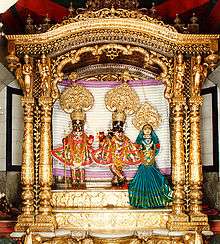
In 1830, Swaminarayan gathered his followers and announced his departure. He later died on 1 June 1830 (Jeth sud 10, Samvat 1886),[81] and it is believed by followers that, at the time of his death, Swaminarayan left Earth for Akshardham, his abode.[20][107] He was cremated according to Hindu rites at Lakshmi Wadi in Gadhada.[108]
Prior to his death, Swaminarayan decided to establish a line of acharyas or preceptors, as his successors.[109] He established two gadis (seats of leadership). One seat was established at Ahmedabad (Nar Narayan Dev Gadi) and the other one at Vadtal (Laxmi Narayan Dev Gadi) on 21 November 1825. Swaminarayan appointed an acharya to each of these gadis to pass on his message to others and to preserve his fellowship, the Swaminarayan Sampradaya. These acharyas came from his immediate family after sending representatives to search them out in Uttar Pradesh.[100] He formally adopted a son from his brothers and appointed them to the office of acharya. Ayodhyaprasad, the son of Swaminarayan's elder brother Rampratap and Raghuvira, the son of his younger brother Ichcharam, were appointed acharyas of the Ahmedabad Gadi and the Vadtal Gadi respectively.[110] Swaminarayan decreed that the office should be hereditary so that acharyas would maintain a direct line of blood descent from his family.[111] The administrative division of his followers into two territorial dioceses is set forth in minute detail in a document written by Swaminarayan called Desh Vibhaag Lekh.[19] Swaminarayan stated to all the devotees and saints to obey both the Acharyas and Gopalanand Swami who was considered as the main pillar and chief ascetic[112] for the sampradaya.[113]
The current acharya of the Ahmedabad Gadi is Koshalendraprasad Pande and Ajendraprasad Pande, of the Vadtal Gadi.[114][115][116]
Decades after his death, several divisions occurred with different understandings of succession. This included the establishment of Bochasanwasi Shri Akshar Purushottam Swaminarayan Sanstha (BAPS), the founder of which left the Vadtal Gadi in 1905, and Maninagar Swaminarayan Gadi Sansthan, the founder of which left the Ahmedabad Gadi in the 1940s. The followers of BAPS hold Gunatitanand Swami as the spiritual successor to Swaminarayan, asserting that on several occasions Swaminarayan revealed to devotees that Gunatitanand Swami was Aksharbrahm manifest. Followers of BAPS believe that the acharyas were given administrative leadership of the sect while Gunatitanand Swami was given spiritual leadership by Swaminarayan.[117] The current spiritual and administrative leader of BAPS is Mahant Swami Maharaj. The followers of the Maninagar Swaminarayan Gadi Sansthan hold Gopalanand Swami as the successor to Swaminarayan.[118][119] The current leader of this sect is Purushottampriyadasji Maharaj.[120]
Following and manifestation belief
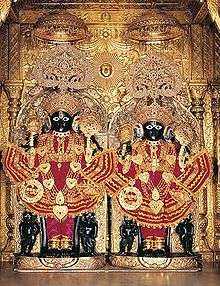
According to the biographer Raymond Williams, when Swaminarayan died, he had a following of 1.8 million people. In 2001, Swaminarayan centres existed on four continents, and the congregation was recorded to be five million, the majority in the homeland of Gujarat.[121][122][123] The newspaper Indian Express estimated members of the Swaminarayan sect of Hinduism to number over 20 million (2 crore) worldwide in 2007.[124]
In his discourses recorded in the Vachanamrut, Swaminarayan mentions that humans would not be able to withstand meeting god in his divine form, hence God takes human form (simultaneously living in his abode) so people can approach, understand and love him in the form of an Avatar.[43] While no detailed statistical information is available, most of the followers of Swaminarayan share a belief that Swaminarayan is the complete manifestation of Narayana or Purushottam Narayana - the Supreme Being and superior to other avatars.[25] A Swaminarayan sectarian legend tells how Narayana from the Nara Narayana pair, was cursed by sage Durvasa to incarnate on the earth as Swaminarayan.[125]
Some of Swaminarayan's followers believe he was an incarnation of Lord Krishna.[43] The images and stories of Swaminarayan and Krishna have coincided in the liturgy of the sect. The story of the birth of Swaminarayan parallels that of Krishna's birth from the scripture Bhagavata Purana.[126] Swaminarayan himself is said to have intimated that he was a manifestation of God in a meeting with Reginald Heber, the Lord Bishop of Calcutta, in 1825.[74]:81
The belief of many followers that their founder was the incarnation of the Supreme God has also drawn criticism.[127] According to Professor Raymond B. Williams, Swaminarayan was criticized because he received large gifts from his followers and dressed and traveled as a Maharaja even though he had taken the vows of renunciation of the world. Swaminarayan responded that he accepts gifts for the emancipation of his followers.[128]
Vedic scriptures support Lord Swaminarayan's existence as the incarnation of the Supreme being. One such scripture of Hinduism is the Skanda Puran (attributed to Rishi Veda Vyasa), which foretells of an incarnation named Narayan Muni (one of the names given to Swaminarayan by his guru Ramanand Swami) to take place in the age of Kali after the Buddha incarnation and before the incarnation of Kalki. The Skanda Puran's Vaishnav Khand's Vasudev Mahatmyam adhyay 18 shlok 42 onwards details this incarnation. It foretells that this incarnation will advent upon the region of Koshal Desh, due to a curse of a muni (Rishi Dursvasa). It mentions this incarnation will establish dharma and be born to Dharma and Bhakti as a Saamvedi Brahmin bestowed with the name Narayan Muni.[129]
See also
Notes
- The word samadhi has different meanings in Hinduism. It may refer to a form yogic deep meditation. As a cause of death, it refers to the act of consciously and intentionally leaving one's body at the time of death.[26]
References
- Williams 2001, p. 13
- Jones, Lindsay (2005). Encyclopedia of Religion. Farmington Hills: Thomson Gale. p. 8889. ISBN 978-0-02-865984-8.
- Williams, Raymond Brady (2001). An introduction to Swaminarayan Hinduism. Cambridge University Press. p. 173. ISBN 978-0-521-65422-7.
- Meller, Helen Elizabeth (1994). Patrick Geddes: social evolutionist and city planner. Routledge. p. 159. ISBN 978-0-415-10393-0.
- Kim, Hanna (19 February 2010). "Public Engagement and Personal Desires: BAPS Swaminarayan Temples and their Contribution to the Discourses on Religion". International Journal of Hindu Studies. 13 (3): 357–390. doi:10.1007/s11407-010-9081-4. ISSN 1022-4556.
- Jones, Lindsay (2005). Encyclopedia of religion. Detroit : Macmillan Reference USA/Thomson Gale, c2005. pp. 8890. ISBN 978-0028659824.
- Paramtattvadas, Sadhu; Williams, Raymond Brady; Amrutvijaydas, Sadhu (April 2016). Swaminarayan and British Contacts in Gujarat in the 1820s. Oxford University Press. pp. 58–93. doi:10.1093/acprof:oso/9780199463749.003.0005. ISBN 9780199086573.
- Hatcher, Brian A. (April 2016). "Situating the Swaminarayan Tradition in the Historiography of Modern Hindu Reform". Swaminarayan Hinduism. Oxford University Press. pp. 6–37. doi:10.1093/acprof:oso/9780199463749.003.0002. ISBN 9780199086573.
- Vasavada, Rabindra (April 2016). "Swaminarayan Temple Building". Swaminarayan Hinduism. Oxford University Press. pp. 257–273. doi:10.1093/acprof:oso/9780199463749.003.0016. ISBN 9780199086573.
- Swami, Manjukeshanand (1831). Paramhansa Namamala. Vadtal, India: Vadtal Swaminarayan Mandir.
- Parikh, Vibhuti (April 2016). "The Swaminarayan Ideology and Kolis in Gujarat". Swaminarayan Hinduism. Oxford University Press. pp. 94–114. doi:10.1093/acprof:oso/9780199463749.003.0006. ISBN 9780199086573.
- Raval, Suresh (2012). Renunciation, Reform and Women in Swaminarayan Hinduism. Ahmedabad, Gujarat, India: Shahibaug Swaminarayan Aksharpith.
- Mangalnidhidas, Sadhu (April 2016). Sahajanand Swami's Approach to Caste. Oxford University Press. pp. 115–128. doi:10.1093/acprof:oso/9780199463749.003.0007. ISBN 9780199086573.
- Williams 2001, p. 141
- Makarand R. Paranjape (2005). Dharma and development: the future of survival. Samvad India. p. 111. ISBN 978-81-901318-3-4. Retrieved 12 September 2009.
- M. Gupta (2004). Let's Know Hindu Gods and Goddesses. Star Publications. p. 33. ISBN 978-81-7650-091-3. Retrieved 15 May 2009.
- "Sampradat history: Nilkanth Varni". Harrow, England: Shree Kutch Satsang Swaminarayan Temple. Archived from the original on 30 June 2009. Retrieved 6 July 2009.
- Williams 2001, p. 15
- Williams 2001, p. 36
- Dinkar Joshi; Yogesh Patel (2005). Glimpses of Indian Culture. Star Publications. pp. 92–93. ISBN 978-81-7650-190-3. Retrieved 7 May 2009.
- Gujarat (India) (1969). Gujarat State Gazetteers: Bhavnagar. Directorate of Govt. Print., Stationery and Publications, Gujarat State. p. 577. Retrieved 15 May 2009.
- Williams 2001, p. 75
- Williams 2001, pp. 16, 17
- "Swaminarayan: Life" (PDF). Shri Swaminarayan Mandir - Somerset, NJ (Vadtaldham). Retrieved 6 July 2009.
- Williams 2001, p. 17
- Williams 2001, p. 240
- Tribes and Castes of the Central Provinces of India. 1. Asian Educational Services, India. 1995. p. 326. ISBN 978-81-206-0833-7.
- Guy L. Beck (24 March 2005). Alternative Krishnas: Regional and Vernacular Variations on a Hindu Deity. SUNY Press. pp. 65–. ISBN 978-0-7914-6415-1.
- Aldwinckle, Russell Foster (1976). More than man: a study in christology. Grand Rapids, Mich: Eerdmans. p. 223. ISBN 978-0-8028-3456-0.
- Anil Kumar Sarkar (1997). Yoga, mathematics, and computer sciences: in change confronting the dawn of the twenty-first century. South Asian Publishers. p. 53. ISBN 978-81-7003-204-5. Retrieved 12 September 2009.
- Williams 2001, pp. 21, 240
- Kirin Narayan (1992). Storytellers, Saints and Scoundrels. Motilal Banarsidass Publ. p. 141. ISBN 978-81-208-1002-0. Retrieved 8 May 2009.
- Williams 2001, p. 21
- Takashi Shinoda (2002). The other Gujarat. Popular Prakashan. p. 9. ISBN 978-81-7154-874-3. Retrieved 27 June 2009.
- Williams 2001, pp. 17, 76, 189
- Cybelle Shattuck; Nancy D. Lewis (2003). The pocket idiot's guide to Hinduism. Alpha Books. pp. 163–165. ISBN 978-0-02-864482-0. Retrieved 12 September 2009.
- Robert Vane Russell (2009) [1916]. The Tribes and Castes of the Central Provinces of India. BiblioBazaar. p. 404. ISBN 978-0-559-11371-0. Retrieved 12 September 2009.
- Rohit Barrot (1987). Richard Burghart (ed.). Caste and sect in Swaminaran Movement. Hinduism in Great Britain. Routledge. pp. 67–70. ISBN 978-0-422-60910-4. Retrieved 8 May 2009.
- Williams 2001, pp. 162
- David Gordon White (2001). Tantra in practice. Motilal Banarsidass Publ. p. 269. ISBN 978-81-208-1778-4. Retrieved 12 September 2009.
- Williams 2001, pp. 77, 165
- S Golwalkar (1997). "Swaminarayan, Pramod Mahajan, Bal Thackeray". In M. G. Chitkara (ed.). Hindutva. APH Pub. Corp. pp. 227–228. ISBN 978-81-7024-798-2.
- Carl Olson (2007). The many colors of Hinduism: a thematic-historical introduction. Rutgers University Press. p. 336. ISBN 978-0-8135-4068-9. Retrieved 12 September 2009.
- Williams 2001, p. 79
- Rudert, A. (2004). "1" (PDF). Inherent Faith and Negotiated Power: Swaminarayan Women in the United States. Cornell University. Retrieved 10 May 2009.
- Mallison, Françoise (April 2016). "Gujarati Socio-religious Context of Swaminarayan Devotion and Doctrine". Swaminarayan Hinduism. Oxford University Press. pp. 49–57. doi:10.1093/acprof:oso/9780199463749.003.0004. ISBN 9780199086573.
- Williams 2001, pp. 165, 167
- Martha Craven Nussbaum (2007). The clash within. Boston: Harvard University Press. pp. 322, 323. ISBN 978-0-674-02482-3. Retrieved 5 May 2009.
- M M Rahman (2006). Encyclopaedia of Historiography. Anmol Publications Pvt. Ltd. pp. 145, 146. ISBN 978-81-261-2305-6. Retrieved 10 June 2009.
- "education of females". Shree Swaminarayan Temple: Sansthan Vadtal. Archived from the original on 1 May 2009. Retrieved 6 July 2009.
- "Swaminarayan's Life - Biography: Uplift of Women". www.swaminarayan.org. Retrieved 7 June 2008.
- Williams 2001, p. 169
- Hardiman, David (10 September 1988). "Class Base of Swaminarayan Sect". Economic and Political Weekly. 23 (37): 1907–1912. JSTOR 4379024.CS1 maint: ref=harv (link)
- McKean, Lisa (1996). Divine Enterprise: Gurus and the Hindu Nationalist Movement. University Of Chicago Press; New edition. p. 18. ISBN 9780226560106.
- Williams 2001, p. 152
- Williams 2001, p. 165
- Kurien, Prema (2007). A Place at the Multicultural Table: The Development of an American Hinduism. University Of Chicago Press; New edition. p. 102. ISBN 9780813540566.
- Williams 2001, p. 167
- "Times Music cassette on Swaminarayan serial launched". Times of India. 19 January 2006. Retrieved 30 March 2009.
- "Food and Water for the Needy". Shree Swaminarayan Temple: Sansthan Vadtal. Archived from the original on 1 May 2009. Retrieved 6 July 2009.
- Williams 2001, p. 170
- Hardiman, David (1988). "Class Base of Swaminarayan Sect". Economic and Political Weekly. 23 (37): 1907–1912. JSTOR 4379024.
- The Camphor Flame: Popular Hinduism and Society in India Christopher John Fuller P. 173
- Williams 2001, pp. 170–171
- Shah, A.M. (2010). The Structure of Indian Society: Then and Now. India: Routledge India. p. 103. ISBN 9780415586221.
- Heber, Reginald (1828). Narrative of a Journey Through the Upper Provinces of India. Boston: Carey, Lea, and Carey. pp. 109.
- Williams 2001, p. 162
- Williams 2001, pp. 57, 77
- Christopher John Fuller (2004). The camphor flame. Princeton University Press. p. 171. ISBN 978-0-691-12048-5. Retrieved 8 May 2009.
- Williams 2001, pp. 24, 159
- Prema A. Kurien (2007). A place at the multicultural table: the development of an American Hinduism. Rutgers University Press. p. 105. ISBN 978-0-8135-4056-6. Retrieved 8 May 2009. Page 105
- Heber, Reginald (10 October 2018). "Narrative of a Journey Through the Upper Provinces of India, from Calcutta to Bombay, Etc" – via Google Books.
- Gazetteer of the Bombay Presidency: Kaira and Panch Maháls. Printed at the Government Central Press. 1879.
- Raymond Brady Williams (2004). Williams on South Asian religions and immigration. Ashgate. ISBN 978-0-7546-3856-8. OL 9414082M. Retrieved 7 May 2009.
- Williams 2001, p. 96
- Williams 2001, p. 189
- Mohan Lal (1992). Encyclopaedia of Indian Literature. Sahitya Akademi. p. 4255. ISBN 978-81-260-1221-3.
- Williams 2004, p. 162
- "Swaminarayan temples". Shri Swaminarayan Temple (ISSO OF CHICAGO). Archived from the original on 24 May 2009. Retrieved 6 July 2009.
- "The foundations of devotion". Asia Africa Intelligence Wire, Financial Times. 4 March 2003. Retrieved 12 March 2009.
- Williams 2001, p. 29
- Williams 2001, p. 107
- Williams 2001, p. 22
- Williams 2001, pp. 187, 189
- Julius Lipner (1998). Hindus: Their Religious Beliefs and Practices. Routledge. p. 124. ISBN 978-0-415-05182-8. Retrieved 12 September 2009.
- Williams 2001, pp. 187–190
- "Shikshapatri". BAPS Swamiranayan Sanstha. Retrieved 10 February 2012.
- Digital Shikshapatri Project. "The Digital Shikshapatri".
- M. G. Chitkara (1997). Hindutva. APH. p. 230. ISBN 978-81-7024-798-2. Retrieved 5 May 2009.
- "Swaminarayan message". www.standagainstswaminarayan.today. 3 June 2016.
- "The Digital Shiksapatri".
- "Digital Shiksapatri slok 108".
- https://web.archive.org/web/20080915161142/http://www.swaminarayanwales.org.uk/Scriptures/scriptures.asp. Archived from the original on 15 September 2008. Missing or empty
|title=(help) - http://www.swaminarayan.info/ShastraDetails.aspx?ID=JgBTAGgAYQBzAHQAcgBhAEkARAA9ADIANAA%3d-cmJRLAFZpY0%3d. Missing or empty
|title=(help) - Brahmadarśanadāsa, Sadhu (2015). Invaluable scriptures of Brahmavidya: Vachanamrut and Swamini Vato. Swaminarayan Aksharpith (1st ed.). Ahmedabad. ISBN 978-81-7526-686-5. OCLC 953775498.
- Brear, Douglas (1996). Williams, Raymond Brady (ed.). Transmission of a Swaminarayan Hindu scripture in the British East Midlands (Columbia University Press ed.). New York: Columbia University Press. ISBN 0-231-10779-X. OCLC 34984234.
- Chitkara, M. G. (1997). Hindutva. APH. p. 228.
- "Six Temples". www.swaminarayan.nu. Retrieved 27 July 2016.
- "In Their Eyes..." Retrieved 7 September 2016.
- Brady Williams, Raymond (2001). An Introduction to Swaminarayan Hinduism. Cambridge University Press. pp. 173. ISBN 9780521654227.
- J. J. Roy Burman (2005). Gujarat Unknown. Mittal Publications. p. 18. ISBN 978-81-8324-052-9. Retrieved 13 June 2009.
- Behramji Merwanji Malabari; Krishnalal M. Jhaveri; Malabari M. B (1997). Gujarat and the Gujaratis. Asian Educational Services. pp. 263–269. ISBN 978-81-206-0651-7. Retrieved 7 May 2009.
- R.V. Russell; R.B.H. Lai (1916). Tribes and Castes of the Central Provinces of India. Asian Educational Services. pp. 328, 329. ISBN 978-81-206-0833-7. Retrieved 7 May 2009.
- Williams 2001, p. 69
- Williams 2001, p. 7
- Williams 2001, p. 57
- Williams 2001, p. 93
- Williams 2001, pp. 34–36
- Williams 2001, p. 34
- Williams 2001, pp. 35–37
- Williams 2001, p. 35
- Williams 2001, pp. 59
- Dave, Ramesh (1978). Sahajanand charitra. University of California: BAPS. pp. 199–200. ISBN 978-8175261525.
- "Narnarayan Devgadi DevGadi Acharyas". Ahmedabad Gadi Official site. 2008. Archived from the original on 31 March 2009. Retrieved 14 September 2009.
- "Acharya Maharajshree Janmotsav Celebration – Junagadh". 9 April 2015.
- NewsGram (18 April 2016). "Spread of Swaminarayan Sampraday across Globe". NewsGram. Retrieved 15 July 2019.
- "Swaminarayan". Archived from the original on 3 June 2010. Retrieved 15 February 2010.
- The camphor flame: popular Hinduism and society in India. Princeton, New Jersey: Princeton University Press. 2004. p. 172. ISBN 978-0-691-12048-5.
- Williams 2001, p. 52
- "Guruparampara". Swaminarayangadi.com.
- Williams 2001, p. 68
- Rinehart, Robin (2004). Contemporary Hinduism. ABC-CLIO. p. 215. ISBN 978-1-57607-905-8. Retrieved 10 May 2009.
- Marcus J. Banks (1985). Review: A New Face of Hinduism: The Swaminarayan Religion. By Raymond Brady Williams. Cambridge University Press: Cambridge, 1984. Pp. xiv, 217. Modern Asian Studies 19 pp 872-874
- "Niche Faiths". Indian Express. 26 May 2007. Retrieved 6 May 2009.
- "Swaminarayan Introduction: Badrikashram Sabha". Ahmedabad Gadi Official site. 2008. Retrieved 14 September 2009.
- Williams 2001, p. 77
- Schmidt, Richard M. (2015). Sages, Saints, and Seers: A Breviary of Spiritual Masters. MOREHOUSE PUBLISHING. p. 114. ISBN 9780819229267.
- Williams 2001, p. 81
- http://vedicreserve.mum.edu/puranas/skanda_purana/skanda_purana_02vaishnava_09vasudeva.pdf
Sources
- Williams, Raymond (2001). Introduction to Swaminarayan Hinduism. Cambridge University Press. ISBN 978-0-521-65422-7.CS1 maint: ref=harv (link)
- Williams, Raymond (2004). Williams on South Asian Religions and Immigration: Collected Works. Ashgate Publishing Ltd. ISBN 978-0-7546-3856-8.CS1 maint: ref=harv (link)
- Dermott Killingley (2003). "Hinduism". In Ridgeon, Lloyd V. J. (ed.). Major world religions: from their origins to the present. London: RoutledgeCurzon. ISBN 978-0-415-29796-7.
- Reginald Heber Lord Bishop of Calcutta - Narrative of a Journey Through the Upper Provinces of India, from Calcutta To Bombay, Volume 2
External links
- Swaminarayan Sampraday
- The Ahmedabad Gadi of the Swaminarayan Sampraday
- The Vadtal Gadi of the Swaminarayan Sampraday
- BAPS
- Shree Swaminarayan Gurukul Rajkot
- Other


